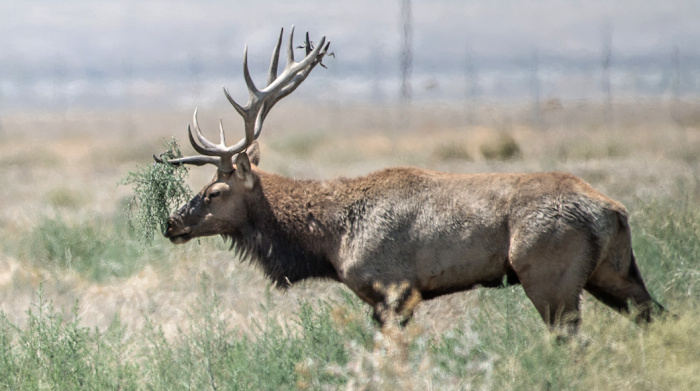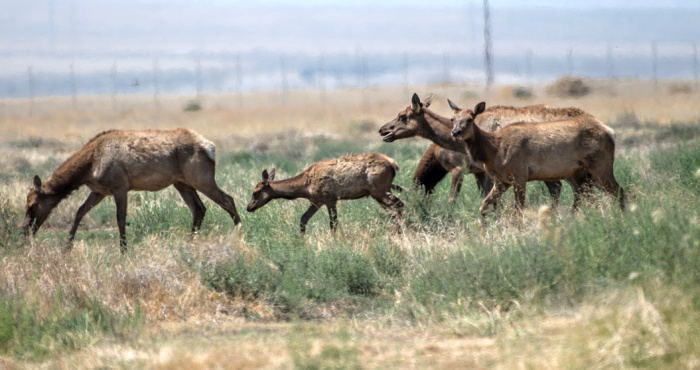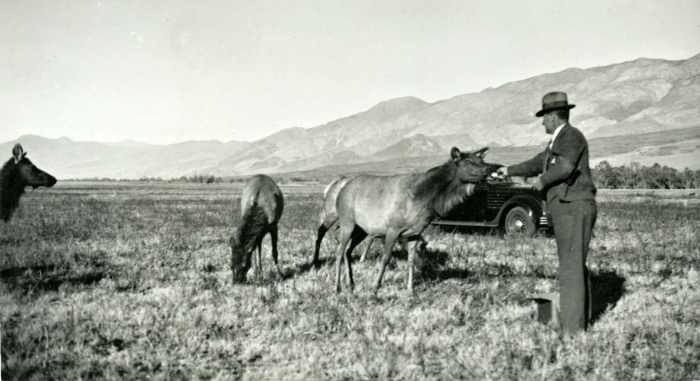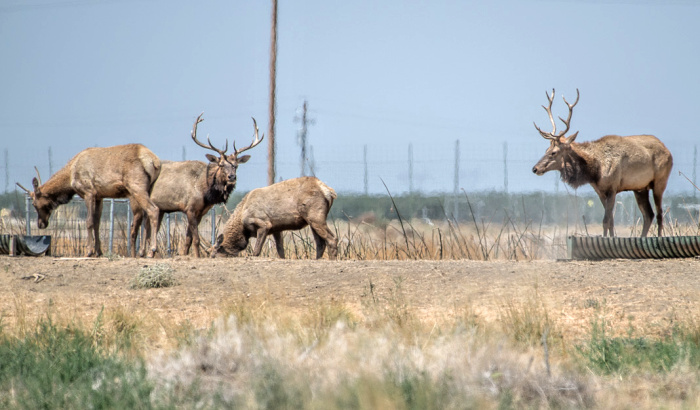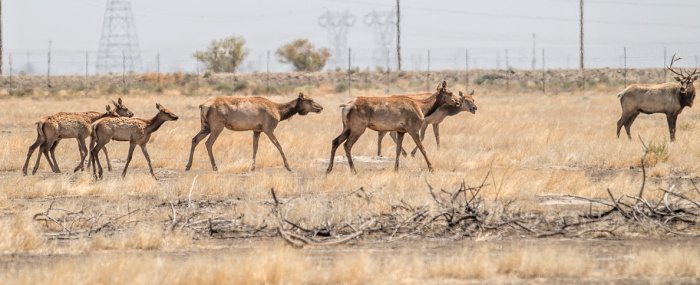The car caravan stopped at a far enough distance for riders to see the standoff of two groupings of tule elk in the open grasslands near Buttonwillow, about an hour north of Los Angeles. Something was catching the attention of the big bull. The yearlings paid careful attention, still standing close to their mothers. At this time of the year, that conflict would normally be another bull which would result in a clash of antlers and head-to-head combat. But this cause for concern was coming from a low-to-the-ground intruder.
Suddenly, the bull charged forward a few feet and out from hiding came a coyote, darting out of sight and searching for another patch of tall grass.
It’s just another day on the range at the Tule Elk State Natural Reserve where a small herd of the small elk continues to contribute to the wildlife landscape of California.
Currently, 28 elk call the Reserve home including 11 females, 10 bulls and 7 new calves, now yearlings. This year is different in terms of herd makeup, says State Park Ranger Bill Moffat. “Usually there is only one alpha male, but now we have two bulls with two harems,” he explains. “This is not the norm and it’s interesting dynamics.”
For SoCal visitors, a stop at the Reserve is a great day trip destination – picnic tables, viewing platform and a nature center under shady trees. Rangers lead auto safaris into the closed-off Reserve twice a month on the second and fourth Sundays (with no second Sundays in November or December).
For those with an adventuresome spirit, the Reserve is hosting an overnight camping experience “Bed and Bugle” on Oct. 15 to Oct. 16 with campfire program, stargazing and guided tours. Come morning, wake to the sounds of bugling elk and you’ll be ready to greet the day. (Want to go? RSVP to bmoffat@parks.ca.gov or (661) 764-6881. Space is limited.)
Whether camping, car safari or checking out the bachelor bulls that like to hang out by the viewing platform, visitors to the Reserve will walk away educated about the elk; a history that, like most wildlife, has been shaped by man.
Once roaming California in herds of 500,000, tule elk are the smallest subspecies of elk, which makes sense since these hoofers aren’t battling heavy snows or fierce winds. Standing next to their massive cousins, the Roosevelt and Rocky Mountain elk, tules are diminutive. Males stand on the average five feet tall at the shoulder and weigh 500 pounds with females about 2/3 of male size.
Being that small didn’t help the elk against white settlers and hunters in the 1870s, who developed a taste for elk meat and found many uses for elk skins and tallow. Because of excessive hunting and elk habitat turned into farmlands, their numbers quickly crashed. Many thought the elk were extinct.
In 1874, cattle rancher Henry Miller hoped to protect any remaining elk by establishing 600 acres of open range land for them. A lone pair was found near Buena Vista Lake and that elk version of Adam and Eve was brought to Miller’s land where they got busy. By 1895, there was a small herd of 28. The elk were on a comeback.
Since that time, the elk have been managed by the California Fish and Wildlife which has relocated and spread herds throughout the state. Today, there are more than 4,000 elk found in 22 isolated herds across California including Point Reyes National Seashore, Wind Wolves Preserve, Carrizo Plain National Monument, San Luis National Wildlife Refuge and others.
But introducing herds back in the wild is not without controversy. There has been friction between elk herds and farmers who want grazing land for livestock, not wildlife. The conflict is ongoing. Additionally, earlier this year, a potentially fatal bacterial disease was discovered in the elk herd at Point Reyes. Elk and other wildlife are very close to roaming cattle which can carry the disease.
At the Reserve, Ranger Moffat says the big issue is the drought. They feed the elk alfalfa and other compatible grasses during the hot summer months and make sure the pumps are working properly on the property ponds. The old steam channel that meanders through the Reserve can fill with water in wet times but that hasn’t happened in years.
Seasonal cycles reflect the elk behavior – which can guide best times to visit the Reserve. April and May are when calves are born, August through October is rutting time between alpha males with “bugling” and charging. Antlers are cast off each winter and regrown throughout the year.
Watching the herd nibble grasses, twitching ears and nuzzling youngsters brings mixed emotions. They are delightful to see, but their sad past presents hard complex consequences for life in the 21st century.
How do the elk belong? Are they still essential to the ecosystem? What will be their place as the landscape continues to change? How is the lack of a natural predator affecting herd mentality?
With grizzlies not coming back soon and mountain lions having their own challenges, the tule elk existence relies on the careful dance of human management to balance genetic diversity, plant propagation on grasses destroyed by too many hoofs, and other aspects of keeping a species alive and active. It’s a very complicated dance but one well-worth continuing for the time being.
— Brenda Rees, editor with photos by Martha Benedict

